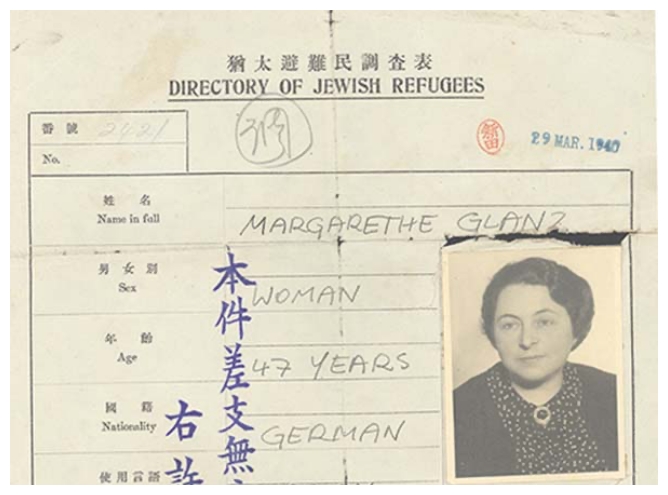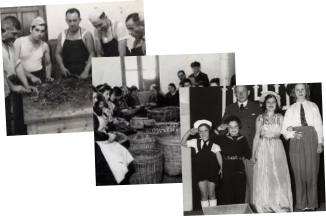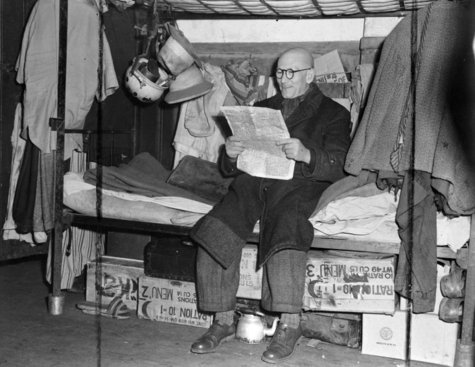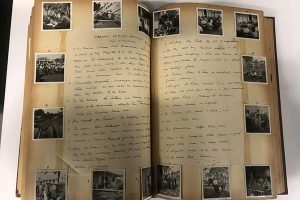JDC Archives Partners with the New York Philharmonic
JDC Archives Photos and Artifacts on Display

The JDC Archives is proudly partnering with the New York Philharmonic Archives to present an exhibition accompanying “Émigré,” a new oratorio set in 1940s Shanghai. For the month of February 2024, visitors to the David Geffen Hall of the New York Philharmonic at Lincoln Center in NYC will be greeted by larger-than-life digital images representing the life of Jewish refugees in Shanghai supported by the JDC during World War II as well as artifacts from the JDC Archives collection. This special collaboration was made possible by JDC Board member and Archives champion Jane Weitzman, who connected JDC to the Philharmonic’s own esteemed Archives to utilize JDC’s collections to contextualize the performance, which makes its United States premiere on February 29 and March 1, 2024. The Archives was also fortunate to leverage the knowledge of Linda Levi, former Director of the JDC Archives, in this collaboration.
Supporting the digital display of photographs on the 50-foot media wall, unique artifacts from the JDC Archives, including scrapbooks, identification cards, and artwork, will further illustrate life in Shanghai for Jewish refugees. These diverse materials transport concertgoers back to wartime Shanghai.
Over 17,000 Jewish refugees from Central Europe sought refuge in Shanghai in 1938-1939, after the Nazi Anschluss. As an open international city, Shanghai was one of the only options for those who could not obtain visas for other countries. The JDC provided life-sustaining support, working through local organizations such as the Committee for the Assistance of European Jewish Refugees in Shanghai (CAEJR), which was organized in 1938. In all, some 20,000 Jewish refugees lived in Shanghai by 1942, the vast majority surviving the war with JDC aid. About two-thirds of the refugees came from Austria and Germany, and the others were from Eastern European countries. Almost all of them left Shanghai after the war, largely with JDC help, moving to the United States, Israel, Australia, and other countries.
A German Jewish refugee reads a newspaper in a JDC Shanghai housing facility for refugees. Shanghai, China, 1946. JDC Archives
JDC sent its representatives Laura Margolis and Manuel Siegel to assist the destitute Jews who faced deplorable sanitary conditions and drastic food shortages. In cooperation with the local CAEJR, Margolis and Siegel built a well-oiled emergency relief operation, including hostels to house the refugees, food programs, and other critical services that sustained the refugees for the duration of the war. Together, they succeeded in organizing a system of emergency relief with the equipment needed to run steam kitchens capable of feeding 10,000 people per day. These kitchens kept the refugees alive. The JDC also provided education, vocational training, built hospitals, and set up emigration offices.
During the planning of the exhibit, a second connection emerged between the JDC Archives and the NY Philharmonic Archives. Leonard Bernstein, Music Director of the NY Philharmonic, also performed at JDC’s request for survivors in the Displaced Persons (DP) camps in Germany. To learn more about the concerts led by Leonard Bernstein as part of JDC’s morale-boosting tours visit the virtual exhibit, Morale-Boosting Tours: Post Holocaust Healing Through the Performing Arts.
To view details of the photographs and artifacts on display at the New York Philharmonic, visit our newest online gallery dedicated to “Émigré.” Explore the resources below to learn more about JDC’s work in Shanghai as well as Leonard Bernstein’s performances.
Shanghai
Topic Guide
Refuge in Shanghai (1938-1953)


Photo Gallery:
China: Shanghai
Blog Posts:
Ming Hui Pan Lectures on the Survival of Jews in China during World War II [includes recording]
Fred Lazin Lectures on JDC and European Refugees in Postwar Shanghai [includes recording]





